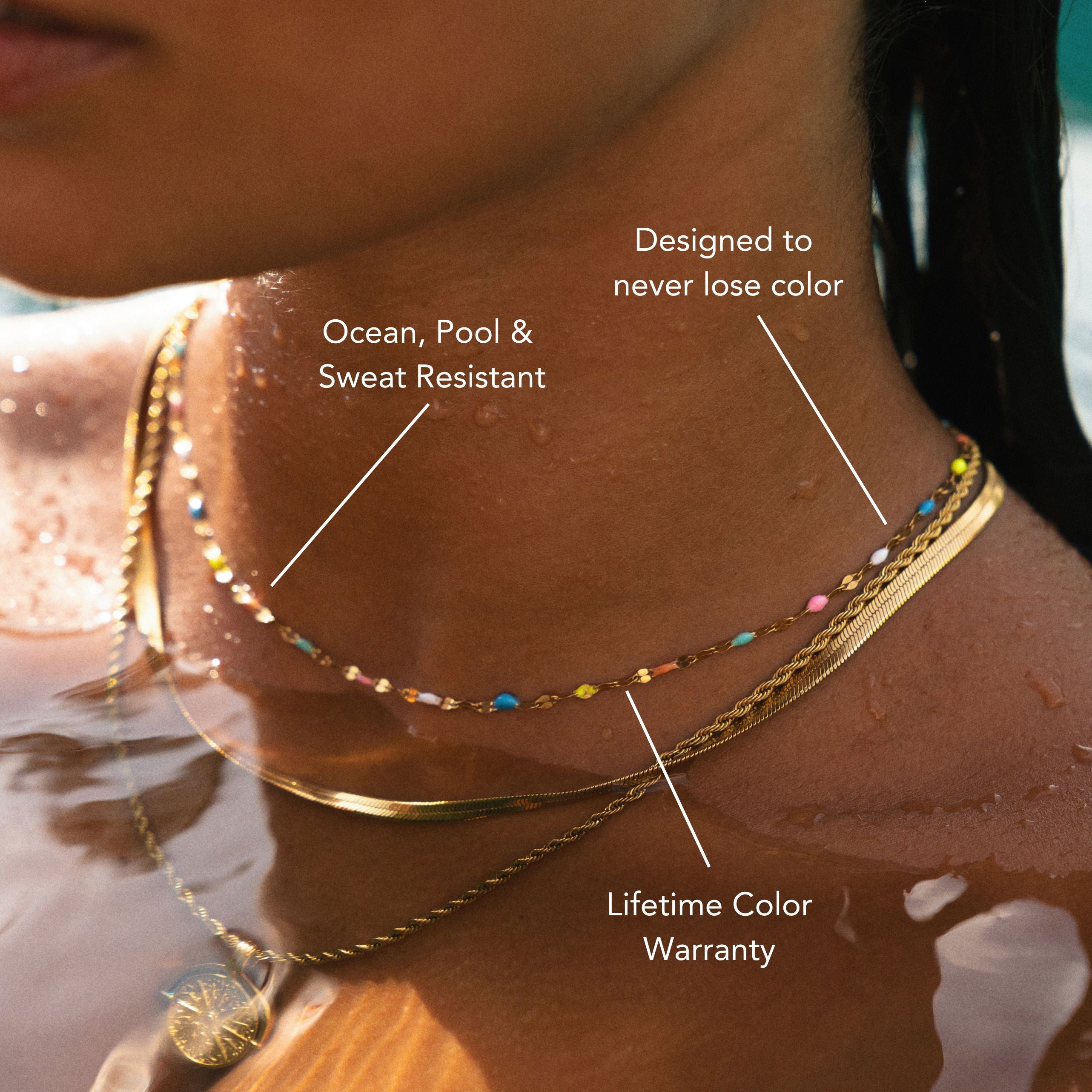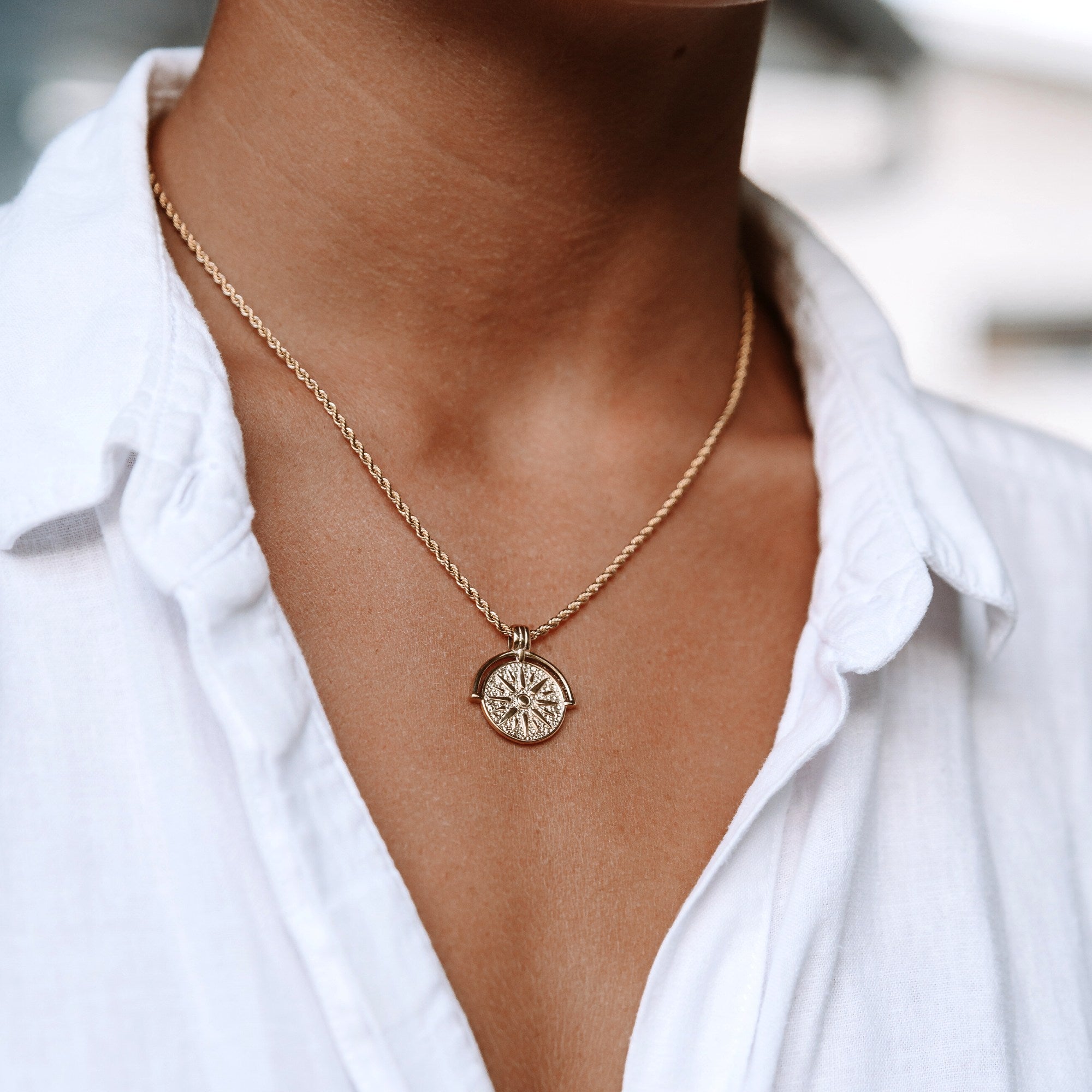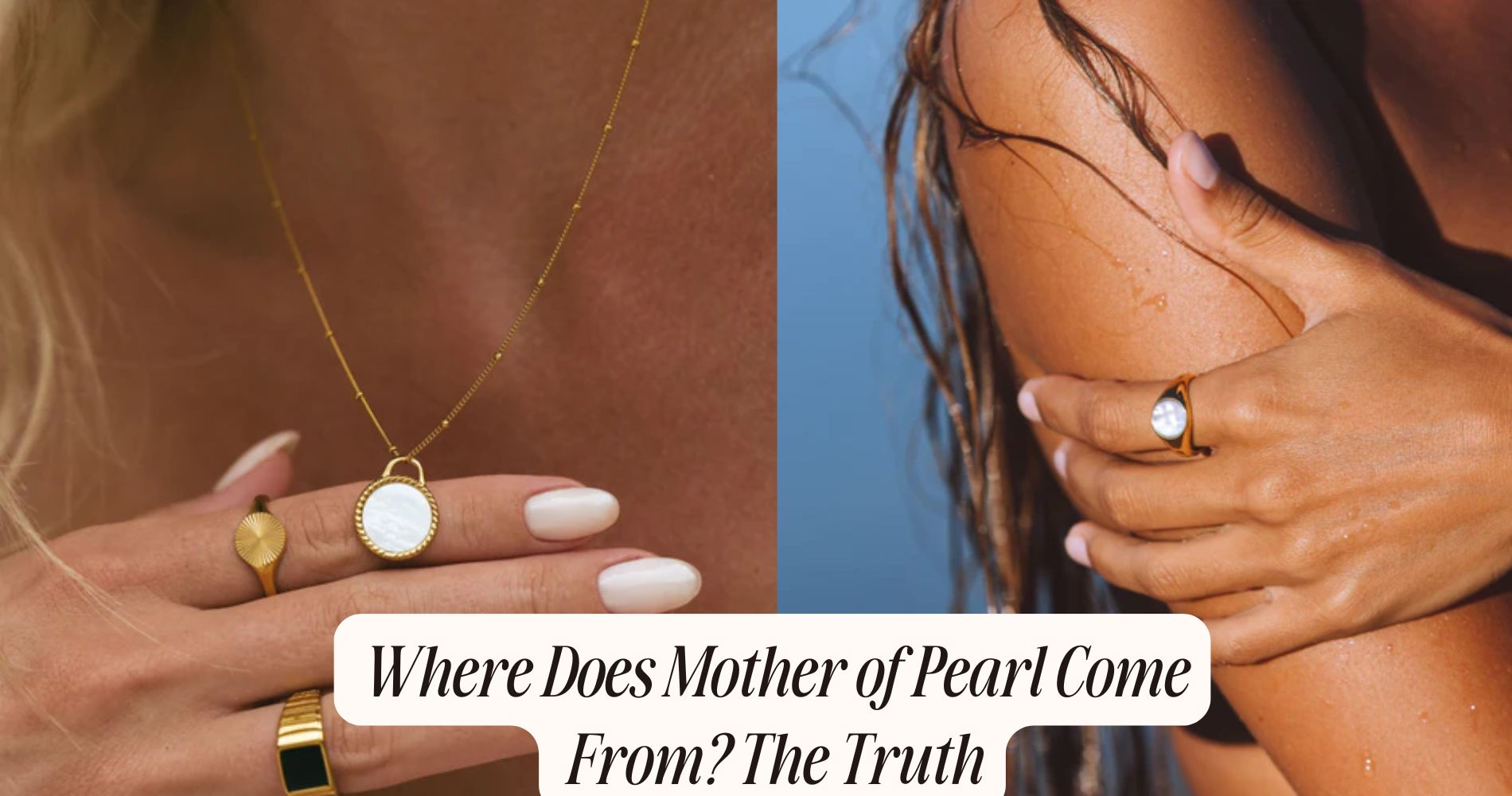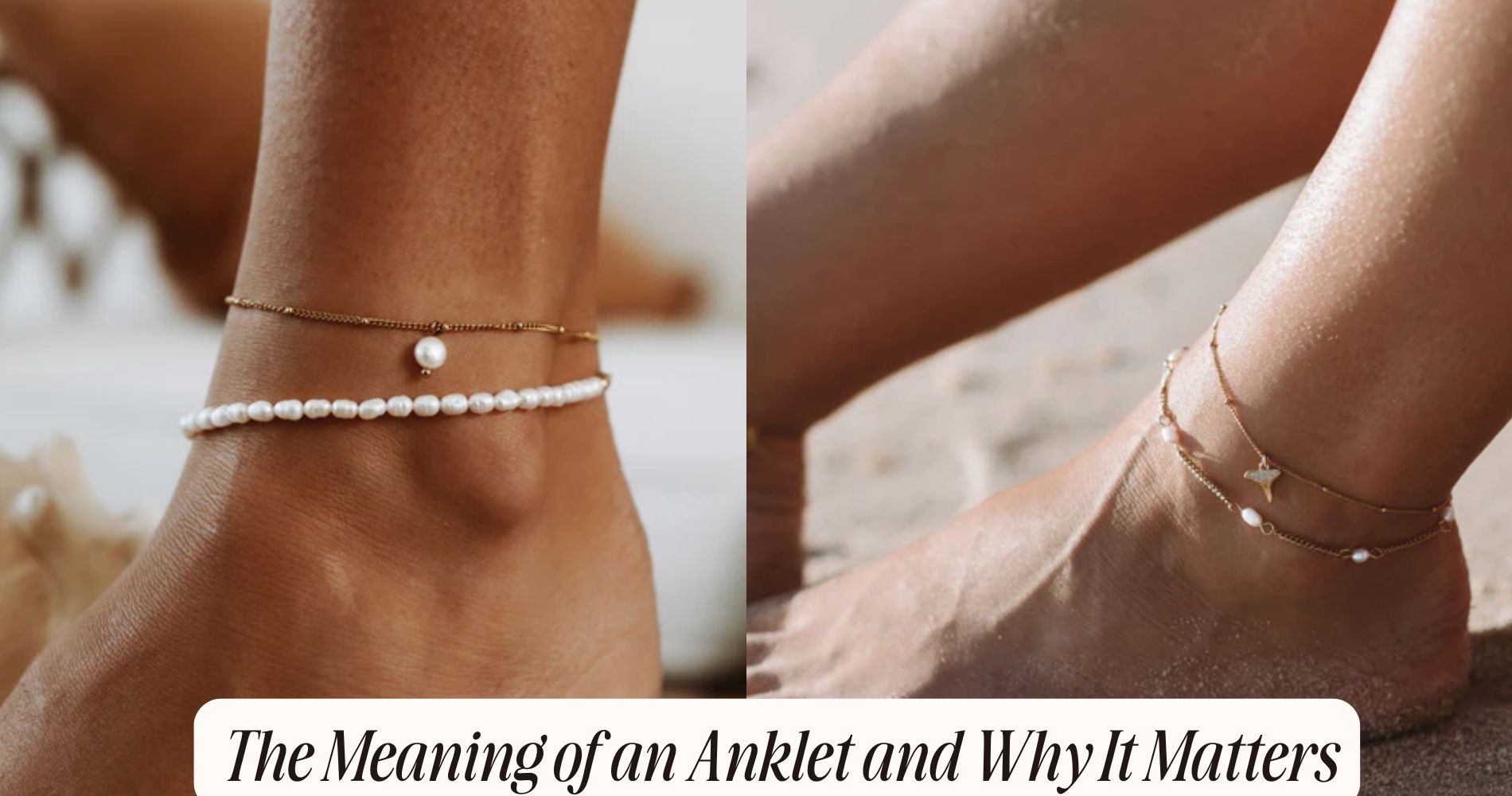
Mother of Pearl vs Opal: What You Need to Know
When considering Mother of Pearl vs Opal, you should note their distinct origins and features. Mother of Pearl, a composite material from mollusks, displays subtle pastel hues and soft elegance, ideal for those seeking tranquility. In contrast, Opal is a vibrant gemstone known for its play of colors and higher durability. It symbolizes creativity and inspiration, making it perfect for statement pieces. Care requirements differ too; Mother of Pearl is softer, while Opal can crack if mishandled. Each offers unique aesthetic and symbolic value, and exploring their qualities further can guide your choice effectively. Discover more through our Tarnish-Free Jewelry collection.
Definition of Mother of Pearl
Mother of pearl, often referred to as nacre, is a composite material produced by various mollusks, particularly oysters and some species of snails. This iridescent substance forms the inner layer of shells, providing a protective lining against irritants.
Beyond its biological function, mother of pearl holds significant cultural importance across various societies. Historically, it's been used in jewelry, ornamentation, and religious artifacts, showcasing its beauty and durability.
In ancient civilizations, artisans crafted intricate designs from mother of pearl for decorative purposes, highlighting its versatility. For instance, in many Asian cultures, mother of pearl was employed in the creation of inlays for furniture and instruments, enhancing aesthetic appeal while symbolizing prosperity and purity. Its reflective qualities made it a sought-after material in art and craftsmanship.
Furthermore, the use of mother of pearl in ceremonial contexts underscores its spiritual significance. It often represents protection and healing, linking it to various cultural beliefs.
Consequently, understanding mother of pearl's definition requires acknowledging its multifaceted roles—both as a natural product and as a meaningful element woven into the fabric of human history.
Definition of Opal
Opal is a unique and enchanting gemstone known for its vibrant play of colors, often referred to as opalescence. This phenomenon occurs due to the internal structure of opal, which diffracts light and creates a mesmerizing display of colors.
The most common types of opal include precious opal, which exhibits this play of color, and common opal, which does not.
In addition to its visual appeal, opal holds significant opal symbolism. It's often associated with creativity, inspiration, and emotional healing. Many believe that wearing opal can enhance one's originality and spark imagination.
In opal mythology, various cultures have revered this gemstone. For instance, ancient Romans considered opals to be a symbol of hope and purity, while Aboriginal Australians viewed opal as a connection to the Dreamtime, embodying spiritual wisdom.
When you explore opals, appreciate not just their beauty but also the rich history and meanings behind them. Understanding opal's symbolism and mythology adds depth to your appreciation of this fascinating gemstone, making it more than just a decorative piece in your collection.
Origins and Formation
Understanding the origins and formation of opal reveals the intricate processes that create this enchanting gemstone. Opals typically form in a marine environment, where silica-rich water seeps into rock fractures and cavities. Over time, this silica solution undergoes a process of crystallization and dehydration, resulting in the formation of opal.
The unique play-of-color characteristic of opal arises from the arrangement of silica spheres, which diffract light, creating a spectrum of colors.
The rarity of opal is influenced by several factors, including the specific geological conditions required for its formation. Unlike other gemstones that might form in a variety of environments, opals need a very particular combination of temperature, pressure, and silica saturation. This rarity contributes to their allure and value in the gemstone market.
Opal deposits are often found in areas that have experienced significant geological changes, such as volcanic activity or sedimentation, which further complicates the formation process.
Consequently, when you think about opal, consider not just its beauty, but the complex journey it undergoes from mineral-rich waters to the stunning gemstone that captivates collectors and jewelry enthusiasts alike.
Physical Properties
When examining the physical properties of opal, you'll find that it possesses a unique combination of characteristics that sets it apart from other gemstones. One of the most notable features of opal is its luster, which can range from vitreous to resinous.
In a luster comparison, opal often displays a more pronounced play of color compared to mother of pearl, giving it a mesmerizing appearance that many collectors and jewelers appreciate.
In terms of hardness, opal ranks between 5.5 to 7 on the Mohs hardness scale. This places it in the mid-range, making it relatively soft compared to harder gemstones like sapphire or diamond. You should handle opal with care to avoid scratching or damaging its surface, especially since its unique play of color can be affected by surface imperfections.
Mother of pearl, on the other hand, has a hardness of about 2.5 to 4.5 on the same scale, making opal the more durable choice for jewelry applications.
Understanding these physical properties helps you make informed decisions when choosing between opal and mother of pearl for your collection or adornments.
Color Variations
When you explore the color variations of mother of pearl and opal, you'll notice a striking natural color spectrum in both materials.
Each gemstone offers a range of hues influenced by their inherent properties and environmental factors.
Additionally, treatment methods can greatly alter these colors, impacting their overall appearance and value.
Natural Color Spectrum
Mother of Pearl and opal both exhibit striking natural color spectrums, showcasing a fascinating array of hues that can enchant any enthusiast.
Mother of Pearl typically displays soft pastels, including whites, pinks, and mild blues, which often symbolize purity and tranquility. These subtle colors arise from the nacre layers, each reflecting light differently, creating a unique finish.
On the other hand, opal is renowned for its vibrant and dynamic color variations, ranging from fiery reds and oranges to cool blues and greens. The phenomenon of opalescence allows it to exhibit multiple colors under varying angles and lighting conditions. This enchanting quality contributes to opal's gemstone rarity, making it highly sought after in the jewelry market.
Both materials not only enhance aesthetic appeal but also carry rich color symbolism. For instance, the deep blues of opal can represent wisdom, while the warm tones of Mother of Pearl evoke feelings of calmness.
Understanding these natural color spectrums helps you appreciate the distinctive qualities of each, guiding your choices whether you're a collector or simply an admirer.
Treatment Effects on Color
Various treatments can greatly affect the color variations of both Mother of Pearl and opal. In your search for these gemstones, it's important to be aware of how color treatments and dye processes can alter their appearance.
For Mother of Pearl, treatments often involve dye processes that enhance or change its natural hues. You might find colors that range from deep blues to vibrant pinks, all achieved through synthetic dyes. While this can create stunning visuals, it's crucial to understand that these colors may not be permanent and can fade over time.
On the other hand, opal can also undergo various treatments to enhance its color. Common practices include heating and impregnating with resins, which can intensify the opalescent effect.
However, these treatments can sometimes affect the stone's integrity. When purchasing opal, it's important to inquire about any treatments that may have been applied, as untreated stones tend to be more valuable and durable.
Uses in Jewelry
In the domain of jewelry design, both mother of pearl and opal serve distinct purposes, each bringing unique qualities to adornments.
Mother of pearl, derived from the inner shell of mollusks, is often used for its lustrous sheen and iridescent finish. Its historical significance dates back centuries, as various cultures have utilized it in jewelry, signifying wealth and prosperity. You'll find mother of pearl incorporated in items like earrings, pendants, and even inlays, where its smooth texture enhances the overall aesthetic.
On the other hand, opal is celebrated for its vibrant play-of-color, making it a favorite for statement pieces. Its cultural symbolism varies globally; in some traditions, opal represents hope and purity, while in others, it's associated with creativity and inspiration.
You might see opal featured in rings, necklaces, and bracelets, where it captures attention and evokes curiosity.
Whether you're drawn to the subtle elegance of mother of pearl or the bold brilliance of opal, both materials offer a rich tapestry of meanings and visual appeal, making them timeless choices in the field of jewelry design.
Care and Maintenance
When caring for mother of pearl and opal, you need to understand the best cleaning techniques to maintain their beauty.
Proper storage is essential to prevent damage, and knowing how to avoid common pitfalls can extend the life of your jewelry.
Cleaning Techniques Explained
Maintaining the luster and beauty of mother of pearl and opal requires careful attention to cleaning techniques. Both materials are delicate and can be easily damaged if not treated properly.
Start with the right cleaning tools; a soft microfiber cloth is ideal for wiping away dust and fingerprints without scratching the surface.
For more thorough cleaning, use a gentle cleaning solution. A mixture of warm water and a few drops of mild dish soap works well. Avoid harsh chemicals or abrasive cleaners, as these can dull the finish or even cause permanent damage.
Dampen your microfiber cloth with the solution, then gently wipe the surface of the mother of pearl or opal. Make sure not to soak the pieces, as excessive moisture can lead to tarnishing or deterioration.
After cleaning, dry your jewelry or items with a separate dry microfiber cloth to prevent water spots.
For intricate designs or settings, a soft-bristled toothbrush can help reach small crevices.
Regular cleaning with these techniques can help preserve the beauty of your mother of pearl and opal, allowing you to enjoy their stunning appearance for years to come.
Storage Recommendations
Proper storage of mother of pearl and opal is essential for preserving their beauty and preventing damage. To maintain both the vibrancy and integrity of these delicate materials, you'll want to prioritize humidity control and temperature stability.
Store mother of pearl and opal in a cool, dry place away from direct sunlight. Excessive heat can cause opal to crack, while high humidity can lead to mold or deterioration in mother of pearl. Aim for a consistent environment, ideally between 60°F and 75°F with a relative humidity of around 40-50%.
Using a soft, padded cloth or a jewelry box lined with fabric can provide additional protection. Avoid plastic containers, as they can trap moisture and create an unstable environment. If you live in a particularly humid area, consider using silica gel packets in your storage to absorb excess moisture.
Regularly check the condition of your stored pieces to guarantee they remain unaffected by environmental changes. By taking these precautions, you'll help maintain the stunning appearance of your mother of pearl and opal for years to come.
Avoiding Damage Tips
To prevent damage to mother of pearl and opal, it's crucial to handle these materials with care during everyday use. Both have unique properties that require specific maintenance practices.
For scratches prevention, always store your jewelry separately, ideally in a soft pouch or lined box. Avoid placing mother of pearl and opal items together, as they can easily scratch each other.
Temperature sensitivity is another critical factor to take into account. Both materials can be adversely affected by extreme temperatures. Keep them away from direct sunlight, heating vents, or areas with significant temperature fluctuations.
When cleaning, use a soft, damp cloth and avoid chemical cleaners, which can cause discoloration or damage.
Additionally, be cautious during activities that may expose your jewelry to rough surfaces or abrasive materials. Remove your pieces when engaging in sports, gardening, or cleaning to minimize the risk of damage.
Choosing the Right Gemstone
When selecting the right gemstone, understanding the unique properties of each option is essential. Mother of Pearl and Opal both have distinct characteristics that appeal to different tastes and needs.
Mother of Pearl, with its iridescent sheen, symbolizes purity and emotional balance. It's often chosen for its calming properties and is ideal if you value tranquility in your life.
On the other hand, Opal captivates with its vibrant play-of-color, symbolizing creativity and inspiration. If you're drawn to artistic expression, Opal might resonate more with your personal preference.
Consider how you plan to wear the gemstone. Mother of Pearl is often seen in jewelry that promotes a soft, subtle elegance, making it suitable for everyday wear. Opal, with its dazzling colors, can be a striking statement piece for special occasions.
Additionally, think about maintenance and durability. Mother of Pearl is relatively softer than Opal, which can be more prone to cracking if not cared for properly.
Ultimately, your choice should reflect not only the gemstone symbolism but also your lifestyle and aesthetic preferences. Take the time to evaluate both options to find the perfect match for you.
Frequently Asked Questions
Are Mother of Pearl and Opal Considered Precious Gemstones?
Mother of pearl isn't classified as a precious gemstone due to its abundance, while opal's rarity factors elevate its status as a semi-precious gemstone. You'll find this distinction important when choosing jewelry.
Can Mother of Pearl and Opal Be Used Interchangeably in Jewelry?
You can't use mother of pearl and opal interchangeably in jewelry. Their color variations and durability comparison reveal distinct qualities, making each suitable for different styles and purposes, so choose wisely based on your needs.
What Is the Price Range for Mother of Pearl and Opal?
The price range for mother of pearl and opal varies greatly. Market factors and quality grading influence costs, with opals often being pricier due to rarity and demand, while mother of pearl remains more affordable.
Are There Any Healing Properties Associated With Mother of Pearl or Opal?
Both mother of pearl and opal are thought to offer healing benefits, promoting emotional balance. You might find that mother of pearl enhances calmness, while opal encourages creativity, making both stones valuable for emotional well-being.
How Do Cultural Perceptions Differ Between Mother of Pearl and Opal?
Cultural perceptions of mother of pearl and opal vary considerably. You'll find that mother of pearl symbolizes purity and emotional balance, while opal often represents creativity and inspiration, reflecting their distinct cultural significance and symbolic meanings across societies.
Conclusion
In conclusion, understanding the differences between mother of pearl and opal can enhance your appreciation for these unique materials. While both offer stunning visual appeal, their origins, physical properties, and care requirements vary greatly. When choosing between them for jewelry or decorative purposes, consider the aesthetic qualities and maintenance needs that align with your lifestyle. By making an informed choice, you can guarantee your selection not only complements your style but also stands the test of time.

























Leave a comment
This site is protected by hCaptcha and the hCaptcha Privacy Policy and Terms of Service apply.